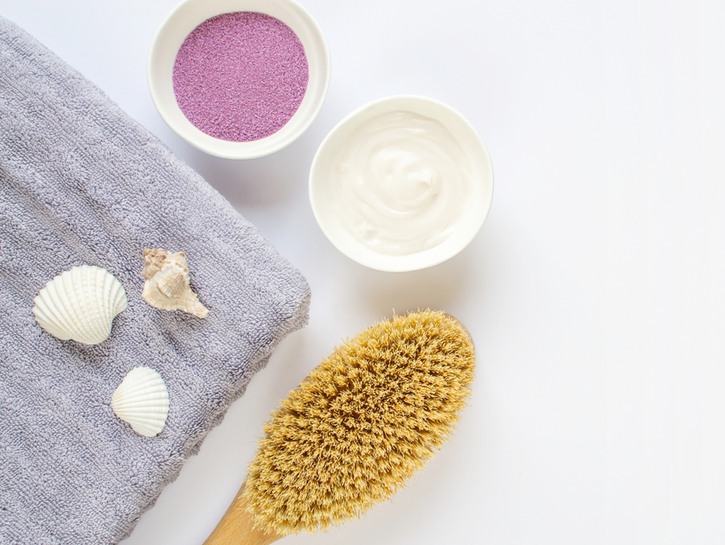Dry brushing is starting to become an essential part of many people’s morning routines. These people view dry brushing as a fast and effective way to give their skin a little TLC at the start each day. But as dry brushing starts to take the world by storm, a lot of people have one question…
What Is Dry Brushing?
Dry brushing is the process of using a stiff-bristled brush to both exfoliate and massage the skin surface by removing layers of dead skin cells in an effort to unclog pores in the skin and stimulate blood flow.
Origin
One might think that dry brushing is a modern phenomenon, but the act of using brushes to exfoliate the skin has been a part of beauty routines for thousands of years. Similar techniques have been seen throughout history in places like Egypt, Greece, Rome, India, China, and Japan.
Dry brushing as it is known today first originated in an ancient form of Hindu traditional medicine called Ayurveda.
Popularity Growth
Over the years, dry brushing became big at top spas around the world, where models and actresses started to spread the world. Models and actresses by the likes of Gwyneth Paltrow, Miranda Kerr, and countless others popularized dry brushing after visiting luxury spas for treatments.
The rest, well, is history.

Benefits
As with most health trends, there are scores of purported health benefits associated with dry brushing, but for most of those, it’s important to look beyond the hype and separate truth from fiction.
Cellulite
There are a lot of claims that dry brushing can reduce the appearance of cellulite due to the fact that the practice helps increase blood circulation, but there are no studies to back up this claim. One possible reason for this misconception could come from the fact that dry brushing temporarily plumps up the skin due to the increase blood flow, which could trick people into thinking their cellulite is disappearing.
Exfoliate
While there might be a whole lot of truth to claims of reducing cellulite, there is one thing that dry brushing actually does: exfoliate dead skin cells. By gently brushing their skin, people who incorporate dry brushing into their daily beauty routine tend to have smoother skin than they did before picking it up and that’s because the brushing helps remove those flakes of dead skin that make for a rougher exterior.
Detox
In addition to removing dead skin cells, some claim dry brushing also helps detoxify the body as it increases blood circulation and promotes the flow and drainage of the lymphatic system.
Improve Circulation
Much like with the detoxification process, using a dry brush to exfoliate the skin also promotes improved blood circulation throughout the body.
Rejuvenates The Nervous System
Dry brushing also helps rejuvenate and refresh the central nervous system, which can help improve muscle tone by stimulating the fibers within the muscles.
Absorb Nutrients
Through the exfoliation process, dry brushing helps get rid of dead skin cells which clears out the pores, allowing the cells that are alive and kicking to soak up and absorb nutrients.

How to Dry Brush
People don’t have to schedule an appointment at an expensive spa in order to reap the benefits of dry brushing. In fact, anyone can do it in the comfort of their own home.
With only one piece of hardware required – a natural bristle brush – dry brushing is one remarkably easy morning routine:
- Brush the dry skin before getting into the shower
- Work in gentle circular, upward motions before working in longer, smoother strokes
- Start at the ankles and work upwards toward the heart to follow the flow of the lymphatic fluids making their way towards the heart
- After working the ankles, move upwards to the legs before reaching the thighs, stomach, back, and arms
- Once the brushing is completed, jump in the shower to remove all of the dead skin cells and impurities that were brought to the surface
- To finish off the process, apply a moisturizer to nourish the skin
Here are a few tips to follow in order to get the most out of the process:
- Alternating the temperature of the water in the shower between hot and cold will help further invigorate the skin as well as stimulate blood circulation
- Refrain from dry brushing whenever there are any lingering skin conditions such as inflamed skin, sores, sun burns, or skin cancer
- Be careful when brushing the softer or more sensitive parts of the skin
When to Dry Brush
Like most beauty practices, there is a proper way to get the most out of dry brushing.
Before shower tips
Always dry brush before hoping into the shower. It’s easier for the brush to pick up the dead skin cells when the surface is nice and dry. Make sure to complete all of the brushing before adding any moisture to the skin surface.
After shower tips
Immediately dry off after getting out of the shower and then apply a body lotion that is high in nutrients. Now is the perfect time for the pores to take in all of the beneficial properties and nutrients of the lotion and allow the newly exposed skin cells to soak them in.
Skin sensitivities
As mentioned above, those interested in incorporating dry brushing into their daily routine should be cautious before they start the process if they have any visible skin conditions.
If someone starts to notice rashes or other breakouts caused by the coarse brushes, they could always resort to using a dry washcloth instead.
